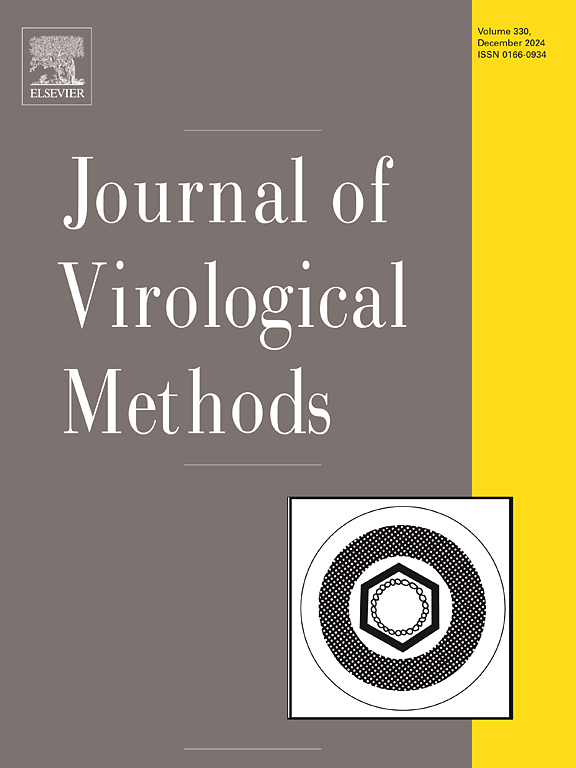利用胶体金纳米粒子免疫传感器和傅里叶变换红外光谱技术定量检测寨卡病毒
IF 1.6
4区 医学
Q3 BIOCHEMICAL RESEARCH METHODS
引用次数: 0
摘要
寨卡病毒(ZIKV)是一种节肢动物传播的病毒,已在世界范围内传播,是寨卡热的病原体,寨卡热是一种全球关注的疾病,其特征是症状轻微,最近与新生儿先天性综合征有关。小头畸形、脑积水、眼畸形和脑膜脑炎是本病的特征。空斑测定法是科学研究实验室用于定量样品上的病毒滴度并评估其与感染剂量关系的金标准。然而,它需要昂贵的基础设施和专门的技术培训。本研究开发了一种基于金纳米粒子的纳米免疫传感器,用于FTIR光谱检测寨卡病毒。通过测定不同浓度的病毒样品中与功能基团相关的吸收带的强度,建立了三条校准曲线来估计ZIKV滴度。检测灵敏度的范围从5 × 10⁴5 ×10 ⁷空斑形成单位/毫升的脂质组(有限公司1750 厘米⁻¹),5 ×10 ³ 5 ×10 ⁷空斑形成单位/毫升为蛋白质组(酰胺我1680 厘米⁻¹),和5 × 10⁵2.2 ×10 ⁸空斑形成单位/毫升碳水化合物组(切断,860 厘米⁻¹)。所提出的方法强调了胶体免疫传感器用于寨卡病毒定量的潜力。本文章由计算机程序翻译,如有差异,请以英文原文为准。
Quantification of Zika virus using a colloidal gold nanoparticle-based immunosensor and Fourier-transform infrared spectroscopy
Zika virus (ZIKV) is an arthropod-borne virus that has spread worldwide and is the etiological agent of Zika fever, a disease of global concern distinguished by mild symptoms and recently linked to a congenital syndrome in neonates. Microcephaly, hydrocephalus, ocular deformations, and meningoencephalitis characterize this disease. The plaque assay is the gold standard used in scientific research laboratories to quantify the virus titer on a sample and assess their relationship with the infectious dosage. However, it requires costly infrastructure and specialized technical training. In this study, a nano-immunosensor based on gold nanoparticles was developed to detect Zika virus using FTIR spectroscopy. Three calibration curves were established to estimate ZIKV titers by measuring the intensity of absorption bands associated with functional groups in viral samples at different concentrations. The detection sensitivity ranged from 5 × 10⁴ to 5 × 10⁷ PFU/mL for the lipid group (C![]() O, 1750 cm⁻¹), 5 × 10 ³ to 5 × 10⁷ PFU/mL for the protein group (amide I, 1680 cm⁻¹), and 5 × 10⁵ to 2.2 × 10⁸ PFU/mL for the carbohydrate group (C-O, 860 cm⁻¹). The proposed method highlights the potential of the colloidal immunosensor for the quantification of the Zika virus.
O, 1750 cm⁻¹), 5 × 10 ³ to 5 × 10⁷ PFU/mL for the protein group (amide I, 1680 cm⁻¹), and 5 × 10⁵ to 2.2 × 10⁸ PFU/mL for the carbohydrate group (C-O, 860 cm⁻¹). The proposed method highlights the potential of the colloidal immunosensor for the quantification of the Zika virus.
求助全文
通过发布文献求助,成功后即可免费获取论文全文。
去求助
来源期刊
CiteScore
5.80
自引率
0.00%
发文量
209
审稿时长
41 days
期刊介绍:
The Journal of Virological Methods focuses on original, high quality research papers that describe novel and comprehensively tested methods which enhance human, animal, plant, bacterial or environmental virology and prions research and discovery.
The methods may include, but not limited to, the study of:
Viral components and morphology-
Virus isolation, propagation and development of viral vectors-
Viral pathogenesis, oncogenesis, vaccines and antivirals-
Virus replication, host-pathogen interactions and responses-
Virus transmission, prevention, control and treatment-
Viral metagenomics and virome-
Virus ecology, adaption and evolution-
Applied virology such as nanotechnology-
Viral diagnosis with novelty and comprehensive evaluation.
We seek articles, systematic reviews, meta-analyses and laboratory protocols that include comprehensive technical details with statistical confirmations that provide validations against current best practice, international standards or quality assurance programs and which advance knowledge in virology leading to improved medical, veterinary or agricultural practices and management.

 求助内容:
求助内容: 应助结果提醒方式:
应助结果提醒方式:


